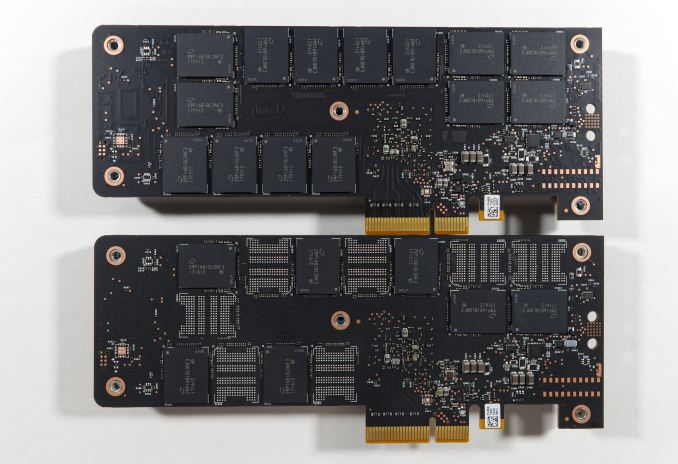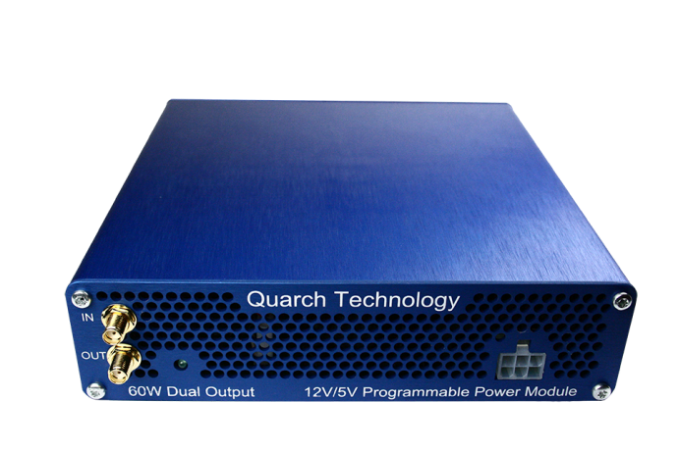The Intel Optane SSD 900p 480GB Review: Diving Deeper Into 3D XPoint
by Billy Tallis on December 15, 2017 12:15 PM EST
Our first look at the Intel Optane SSD 900p only included the smaller 280GB capacity. We now have added the 480GB model to our collection, and have started analyzing the power consumption of the fastest SSDs on the market.
This second look at the Optane SSD 900p doesn't change the overall picture much. As we speculated in our initial review, the design of the Optane SSD and its 3D XPoint memory means that performance does not scale with capacity the way most flash-based SSD designs do. The Optane SSD 900p uses a controller with seven channels for communicating with the 3D XPoint memory. The difference between the 280GB and 480GB models is merely a difference of three or five 3D XPoint dies per channel. Of the 28 memory package locations on the PCB, the 280GB model populates 21 with single die packages. The 480GB model uses all 28 spots, and half of the packages on the front are dual-die packages.
A single NAND flash die isn't enough to keep one of the controller's channels busy, because flash takes many microseconds to complete a read or write command, and even longer for erase commands. By contrast, 3D XPoint memory is fast enough that there is little to no performance to be gained from overlapping commands to multiple dies on a single channel. Increasing the number of dies per channel on an Optane SSD affects capacity and power consumption but not performance.
Intel recently let slip the existence of 960GB and 1.5TB versions of the 900p, through the disclosure of a product change notification about tweaks to the product labeling. The specifications for the larger capacities have not been confirmed but likely match the smaller models in every respect except power consumption. Since Intel has not officially announced the higher capacities yet, no MSRP or release date is available.
| Intel Optane SSD 900P Specifications | ||||
| Capacity | 280 GB | 480 GB | 960 GB | 1.5 TB |
| Controller | Intel SLL3D | |||
| Memory | Intel 128Gb 3D XPoint | |||
| Interface | PCIe 3.0 x4 | |||
| Form Factor | HHHL Add-in card or 2.5" 15mm U.2 |
HHHL Add-in card | HHHL Add-in card (U.2 unknown) |
|
| Sequential Read | 2500 MB/s | TBD | ||
| Sequential Write | 2000 MB/s | TBD | ||
| Random Read IOPS | 550k | TBD | ||
| Random Write IOPS | 500k | TBD | ||
| Power Consumption | 8W Read 13W Write 14W Burst 5W Idle |
<20.5 W | <24 W | |
| Write Endurance | 10 DWPD | TBD | ||
| Warranty | 5 years | TBD | ||
| Recommended Price | $389 ($1.39/GB) | $599 ($1.25/GB) | TBD | TBD |
Our SSD power measurement equipment burned out right before our first Optane SSD arrived. As of this week, we have newer and much better power measurement equipment on hand: a Quarch XLC Programmable Power Module. We'll explore its capabilities more in a future article. For now, we're filling in the missing power measurements from the past several reviews. Both of the Optane SSD 900p models have been re-tested with the Quarch power module on the entire test suite except for The Destroyer (so far). We haven't yet thoroughly validated the new power measurements against the results from our old meter so there may be some discrepancies, but the Optane SSDs draw so much power that any minor differences won't matter to this review. Everything that was tested with the old meter will eventually be re-tested on the Quarch power module, but we don't expect significant changes except to idle power measurements (where the Quarch power module should offer higher resolution).
Our first review of the Optane SSD 900p included a few puzzling results, most notably slightly higher performance when the ATSB Heavy and Light tests were run on a filled drive than when the Optane SSDs were freshly erased. One potential factor for this has since come to light: After first being powered on, Intel Optane SSDs perform a background data refresh process. This isn't necessary unless the SSD has been powered off for a long time, but the drive has no way to know how long it was without power. The documentation for the 750GB Optane SSD DC P4800X states this process can take up to three hours. We have not observed any clear transition in idle power during the first few hours after power-on, but there are occasional short periods where idle power drops by around 350-400mW (from around 3.5W).
Without a conclusive indication of whether background data refresh is happening and influencing benchmark results, we've re-tested the 280GB Optane SSD 900p for this review. Before running the synthetic benchmarks, the 900p was allowed to sit at idle for at least three hours. The ATSB tests were also conducted after an extended idle period, but the test system was rebooted between ATSB tests. Even with this precaution, there's still significant variability between test runs on the Optane SSD 900p and the full-drive performance is often better than freshly erased, so it appears there's another factor contributing to this behavior.
| AnandTech 2017 SSD Testbed | |
| CPU | Intel Xeon E3 1240 v5 |
| Motherboard | ASRock Fatal1ty E3V5 Performance Gaming/OC |
| Chipset | Intel C232 |
| Memory | 4x 8GB G.SKILL Ripjaws DDR4-2400 CL15 |
| Graphics | AMD Radeon HD 5450, 1920x1200@60Hz |
| Software | Windows 10 x64, version 1703 |
| Linux kernel version 4.12, fio version 2.21 | |
- Thanks to Intel for the Xeon E3 1240 v5 CPU
- Thanks to ASRock for the E3V5 Performance Gaming/OC
- Thanks to G.SKILL for the Ripjaws DDR4-2400 RAM
- Thanks to Corsair for the RM750 power supply, Carbide 200R case, and Hydro H60 CPU cooler
- Thanks to Quarch for the XLC Programmable Power Module and accessories












69 Comments
View All Comments
Billy Tallis - Friday, December 15, 2017 - link
The ATSB tests are Windows-based, and the synthetic tests are on Linux with fio. I can't really create a RAM disk large enough to properly run the ATSB tests (at least not on this system), but I'll look into running the synthetic tests against a RAM disk.tuxRoller - Saturday, December 16, 2017 - link
Thanks so much for the response and clarification.I'll keep an eye out for that ramdisk comparison:)
Chaser - Friday, December 15, 2017 - link
In other words, if you are the enthusiast gamer person like many of the people that read this site, you're throwing money away buying this for your gaming system.jabber - Friday, December 15, 2017 - link
You are pretty much throwing away money investing in anything faster than a 850EVO in a gaming rig.eek2121 - Sunday, December 17, 2017 - link
Not really, as a gamer, you should not only be looking at performance, but at reliability as well. Ironically I say this NOT because the 8xx EVO is crap (my 840 evo still has 93% life left and that's despite being used as a system drive for many years), but because my 960 evo has had a metric ton of degradation in the 6 months I've owned it.Klimax - Sunday, December 17, 2017 - link
Only if one has few games. There's better solution: 16GB of RAM + large regular HDD (WD Black and similar, their sequential reads are very good). Only initial load will be noticeable. (Anytime after that, caching will take care of that)CheapSushi - Friday, December 15, 2017 - link
Umm, what? Optane would be the better drive in every single way for OS and general usage. If you were going to get ONE main drive, it should be Optane.ddriver - Friday, December 15, 2017 - link
Sure, but is 0.01% faster in real world performance worth being 300$ more expensive? If you are going with one main drive, you better get better capacity than performance you can't make any use of.tricomp - Saturday, December 16, 2017 - link
Here is what Tom wrote about Optane OS drive : "You will see and feel a performance benefit just by using the Optane SSD 900P as your operating system drive. The feel of the system changes even if you’re replacing a high-performance NVMe SSD. You will notice the increased responsiveness immediately and then gradually become accustomed to it. In our experience, you will take the performance for granted until you work on a slower PC. Then you'll wish it had an Optane SSD." Its main advantage - 4K read performance - makes it OS kingeek2121 - Sunday, December 17, 2017 - link
"Tom" has been gone for a long time. Tom's hardware, much like AnandTech, has simply become a vehicle for Purch Ads (sadly). The AnandTech or Tom's Hardware of today have absolutely nothing to do with the original founders/sites. I don't mean to sound anti-corporate (because I'm not), but Purch has allowed pretty much all of their sites to degrade to the point where they have become irrelevant. I mean no disrespect to any AT folks either. I'm sure they bust their asses off. However, IMO, Purch has taken some very valuable brands and driven them into the ground in a desperate reach for revenue.